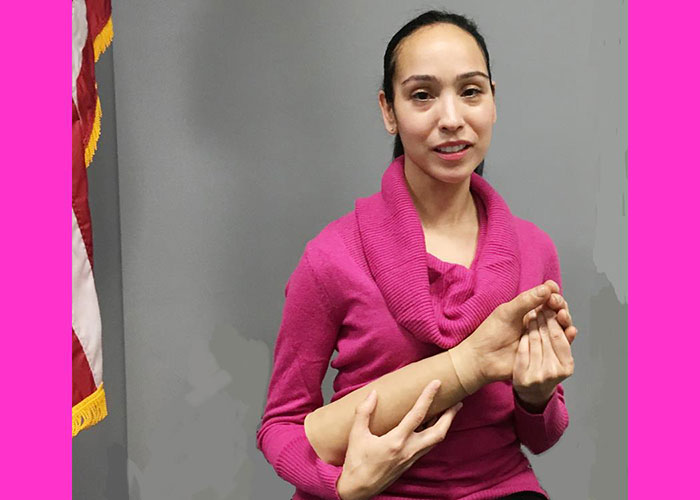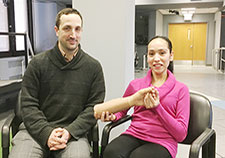Office of Research & Development |
 |


Dr. Roxanne Disla, an occupational therapist specializing in prosthetics care and research, is with the VA New York Harbor Healthcare System. (Photo by Claudie Benjamin)
February 8, 2018

Dr. Jason Maikos, director of the Gait and Motion Analysis Laboratory at VA’s Manhattan campus, is collaborating with Dr. Roxanne Disla on a study of the unique needs of women Veterans living with amputations. ((Photo by Claudie Benjamin)
Dr. Roxanne Disla was first inspired to become an occupational therapist as a nine-year-old, when she saw the profound effect the therapy had on her sister, who was born with developmental disabilities.
One highlight of her career so far has been serving as the lead occupational therapist at the Manhattan site for VA’s team on the LUKE arm research project. The high-tech prosthetic arm was developed by DEKA Integrated Solutions Corporation with $40 million in funding from the Defense Advanced Research Projects Agency (DARPA), through its Revolutionizing Prosthetics Program. It is the first prosthetic arm capable of performing multiple simultaneous powered movements. In July 2017, two Veterans became the first VA patients to receive the arm for daily use.
Now, Disla has shifted her focus to the specific needs of women with amputation. She recently received a research grant from the Department of Defense to help determine the unique physical and psychosocial needs of women living with amputation.
Defense statistics show that 27 female service members underwent traumatic limb amputations in the wars in Iraq and Afghanistan. In 2016, VA served more than 1,800 female Veterans with amputations, most relating to illness or non-combat injuries.
"There is a growing population of women living with amputations, specifically in the VA and DoD healthcare systems, yet little research has been conducted to understand the unique needs of this population."
“There is a growing population of women living with amputations, specifically in the VA and DoD healthcare systems, yet little research has been conducted to understand the unique needs of this population,” wrote Disla in a study abstract.
The lack of studies, says Disla, makes it harder for clinicians to make evidence-based recommendations for their female patients with amputations.
Disla plans to help fill the evidence gap. She is working with Dr. Jason Maikos, director of the Gait and Motion Analysis Laboratory at VA’s New York Campus, and with Walter Reed National Military Medical Center, New York University, and several VA medical centers across the country. Their three-year project will feature an online survey designed to collect data on the unique impact of amputation on women in the physical, psychological, and social realms.
The survey will be crafted to address the wide spectrum of issues facing women with amputation, whether Veterans, current service members, or civilians with no military history.
Disla says women have higher rates of artificial limb rejection, and they are more prone to complications stemming from amputation and prosthetics use, such as osteoarthritis in the opposing leg. Furthermore, most prosthetic devices, even the more advanced ones, are designed primarily for the average male.
“Commercially available prosthetic components tend not to be gender-specific and are designed with male anthropometry and biomechanics,” wrote Disla, “which leads to greater dissatisfaction with prosthetic fit and appearance for women living with amputation.”
The goal is to recruit 200 patients throughout the U.S. into the study. The sample will include 100 women and 100 men, for comparison. The researchers hope the information they gather will help guide clinical care and translate into better health outcomes for women living with amputations.
Says Disla, “Our goal is to be very comprehensive so we can address all the patients’ needs.”
Adapted from an article by Claudie Benjamin, Public Affairs Officer at the VA New York Harbor Healthcare System, originally posted on Feb. 6, 2018, at www.facebook.com/notes/va-ny-harbor-healthcare-system/arm-for-a-woman/2223372391010129.
VA Research Currents archives || Sign up for VA Research updates